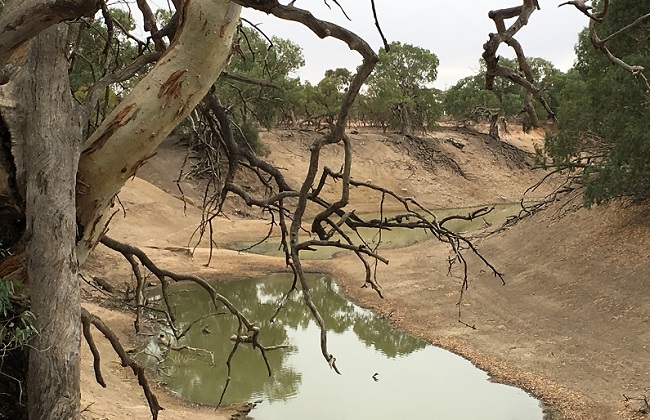Part 1 in a series on water law and the Murray-Darling Basin
By Special Counsel Dr Emma Carmody
Everyone should care about water, and how it is managed. This is particularly true in Australia due to its scarcity, which is already being exacerbated by climate change in certain parts of the country.
This article is the first in a series examining different areas of water law and sets out recommendations for reform. While the focus is the Murray-Darling Basin, many of the legal principles and recommendations are applicable in other catchments.
Connectivity
The first issue addressed in this series is that of connectivity, which in simple terms refers to the flow of water down the length of a river (longitudinal connectivity) and when rainfall is significant enough, across floodplains and wetlands (latitudinal connectivity). Connectivity can also refer to groundwater connectivity with surface waters. This article will focus on longitudinal connectivity between the northern Murray-Darling Basin (in particular the Barwon-Darling River and its tributaries in north west New South Wales) and the Lower Darling River, which is located below the Menindee Lakes in south-western New South Wales. However, our recommendations can be applied to other catchments.
What is the problem?
The law can either help or hinder connectivity. For example, legal instruments known as water sharing plans (WSPs)[1] that dictate how much water can be taken by water users in the upstream section of a catchment may hinder connectivity if they fail to adequately take into account the needs of water users, Traditional Owners and the environment further downstream within the same catchment.
The same can also be true between catchments. For example, a WSP governing water extractions in an upstream catchment may not adequately consider the impacts of extraction on flows and users in downstream catchments (which are governed by separate WSPs).
This may result in unsustainably long periods of no or low flows, as well as insufficient volumes of water to regenerate downstream ecosystems after extended periods of drought.
Unfortunately, current and proposed WSPs do not adequately protect connectivity, which is required to meet the Basin Plan objective of ‘healthy and resilient ecosystems with rivers and creeks regularly connected to their floodplains and, ultimately, the ocean.’[2]

What are the legal consequences under state laws?
Oversights of this nature may have specific legal consequences. For example, the Water Management Act 2000 (NSW) (WM Act) sets out mandatory water management principles regarding the sharing of water (Water Sharing Principles). The Water Sharing Principles require the sharing and extraction of water to protect water sources and their dependent ecosystems first and foremost, followed by basic landholder rights (comprising stock and domestic rights, harvestable rights and Native Title rights).[3]
The WM Act also includes ‘priority of use’ provisions which require extractions under licences for town water and stock and domestic use to take precedence over licences for irrigation.[4]
Failure to adequately restrict the volume and/or timing of extractions for irrigation (either from rivers or floodplains) could therefore result in breaches of the Water Sharing Principles and/or the priority of use provisions set out in the WM Act.
Any newly made or amended WSP that fails to include provisions capable of satisfying the Water Sharing Principles (or which includes rules that contravene the Water Sharing Principles) could potentially be subject to a form of legal challenge known as ‘judicial review’ in the Land and Environment Court of New South Wales (LEC).[5] It is arguable that this could extend to upstream WSPs that prejudice the proper implementation of the Water Sharing Principles in downstream WSP areas.
Furthermore, a failure on the part of the Minister or their delegate to exercise their functions consistently with the Water Sharing Principles or to observe the priority of use provisions could also give rise to judicial review proceedings in relation to the decision in question. It is also possible that a failure of this nature could result in a different kind of legal challenge known as ‘civil enforcement proceedings’, also in the LEC.[6]
It is important to note that during periods of ‘severe water shortage’ or ‘extreme events’, the Minister may suspend WSPs and make water determinations that vary the priority of use provisions.[7] However, in both of these scenarios, water for human consumption is at the top of the hierarchy, and the legal challenges referred to above continue to apply.
What about Commonwealth laws?
Any WSP that falls within the Murray-Darling Basin is also subject to the requirements of the Water Act 2007 (Cth) and Basin Plan. These WSPs must, for example, provide for the coordination of environmental watering between different, but connected, river systems;[8] more generally, they must also be capable of meeting the overarching international obligations which underpin the Act (in particular in relation to biodiversity and wetlands).[9] A WSP that is inconsistent with these international obligations could potentially be challenged in the Federal Court of Australia on constitutional grounds.
The Basin Plan also requires rules to be included in WSPs where such rules are necessary to meet the environmental watering needs of priority environmental assets (PEAs) and priority ecosystem functions (PEFs)[10]. It is arguable that this extends to upstream WSPs including – where necessary – rules to help meet the watering requirements of PEAs and PEFs in downstream catchments.[11]
PEAs, PEFs and their watering needs are supposed to be identified in long-term watering plans for each catchment.[12] There is concern that some WSPs may not contain adequate rules to meet the watering needs of PEAs and PEFs either within a catchment or in downstream connected catchments. Where this is the case, Federal accreditation of such WSPs could be subject to judicial review in the Federal Court of Australia.[13]
Recommendations
The Basin Plan was enacted to ensure that Basin water resources were managed in a coherent, integrated fashion rather than (exclusively) on the basis of state borders and statutory boundaries.[14] This worthy objective will be undermined if WSPs do not properly facilitate connectivity within and between WSP areas. To that end, we recommend the following:
- End of system flow targets be set in each of the WSPs for the tributaries to the Barwon-Darling River. These should be based on best-available evidence and with a view to maintaining the Water Sharing Principles, priority of use rules and the watering needs of PEAs and PEFs both in the tributaries and where relevant, further downstream in the Barwon-Darling River, Menindee Lakes and Lower Darling River. These targets should be assessed regularly and linked to enforceable rules which prevent upstream extraction until they are met.
- Mandatory rules in each of the WSP for the tributaries of the Barwon-Darling River that limit extractions to protect low flows and environmental flows (noting that some of these outcomes may be achieved under Recommendation 1). While some of these WSPs do include provisions to protect environmental flows, they are triggered at the discretion of the Minister (and are arguably limited in their scope and to that extent may be inadequate to achieve the required outcomes).
- Mandatory rules in the Barwon-Darling WSP that limit extractions to protect low flows and environmental flows. While the Draft Barwon-Darling WSP includes rules to protect environmental flows, these are triggered at the discretion of the Minister.[15]
- A rule in the Barwon-Darling WSP that requires the Menindee Lakes to reach 400GL after a prolonged dry period to ensure that there is sufficient water in reserve in the Lakes to meet basic landholder rights on the Lower Darling for the next 18 months, maintain water quality, reduce the risk of fish kills, provide habitat for listed species and provide for cultural flows.[16] Flow targets further upstream must be aligned with this goal.
- A review of all trade and account management rules for each of the WSPs for the tributaries that flow into the Barwon-Darling River to assess whether they contain rules that are contrary to the Water Sharing Principles, priority of use provisions or watering needs of PEAs and PEFs in the tributaries and where relevant, further downstream in the Barwon-Darling River. Where necessary, the rules should be amended to meet these legal requirements.
To clarify, we can see no legal impediment to WSPs including rules designed to protect flows in downstream catchments. Further, and as noted by the Australian Academy of Science in its report on the 2018-19 fish kills, the WSPs that are to come into effect under the Basin Plan:
…should address the panel’s key findings on the fish kill and algal blooms in the Darling River. Pertinently, there is a need to ensure stronger integration between upstream and downstream water resource plans in the Northern Basin to meet the holistic and interconnected objectives of ‘good’ water, connectivity, and inclusion of Indigenous values.[17]
Our next article in this series will examine the interface between climate change and water law.
- [1] These are known as Water Resources Plans (WRPs) in the Murray-Darling Basin (however WSP are one of the instruments that make up a WRP). For ease of reference, we are only using the term WSP.
- [2] Basin Plan, cl. 5.02(2)(c).
- [3] WM Act, s. 5(3); Dictionary (definition of Basic Landholder Rights).
- [4] WM Act, s. 58(1).
- [5] WM Act, s. 9(1)(a),(b); s. 47.
- [6] WM Act, s. 9(1)(b), s. 336.
- [7] WM Act, ss. 49A, 49B, 60(3), 60(3A), 60(3C).
- [8] Basin Plan, cl. 10.17.
- [9] Water Act, ss. (3)(b), 9.
- [10] Basin Plan, cl. 10.17.
- [11] See wording of Basin Plan, cl. 10.17; cl 8.19 (in particular 8.19(4)(b)).
- [12] Basin Plan, cl. 8.19.
- [13] Basin Plan, ss. 56(1), 63(6). The latter states that the Minister must accredit a WSP where they are satisfied that it is consistent with the Basin Plan. A decision to accredit a WSP could be challenged on the basis that the Minister could not have been satisfied – on a correct understanding of the law – that the WSP in question was consistent with the Basin Plan. See for example: Goundar v Minister for Immigration and Border Protection [2016] FCA 1203.
- [14] Basin Plan, cl. 20.
- [15] Draft Water Sharing Plan for the Barwon-Darling Unregulated River Water Source 2012 (Draft WSP), cl.42A(4). Note that in addition to being discretionary, the details regarding daily extraction limits (IDELs or IDECs) are to be contained in the ‘Active Management Procedures Manual’ which is not publicly available. Further, the Draft WSP does not include total daily extraction limits (TDELs). Rather, it depends on the Minister exercising their discretion to trigger active management of a flow event and set limits on extraction for a management zone. See Draft WSP, cl. 42A(4).
- [16] Minimum 400GL in Menindee Lakes reserve recommended by the Australian Academy of Science. See AAS, Investigation of the causes of mass fish kills in the Menindee region over the summer of 2018-2019, February 2019, p.54.
- [17] Ibid, p. 52.




